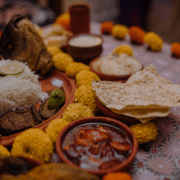Buddhist vegetarianism has fairly well penetrated the Indian vegetarian food practices. Buddhist cuisine places emphasis on very simple and pure food prepared without animal meat, as well as non-violence towards all sentient beings. Evidence of this influence can also be seen in the increased adoption of the vegetarian diet in many Indian states where the monastic cuisine has merged with the regional cooking style, thus spreading vegetarian modalities.
Tenets of Buddhist Vegetarianism
A Buddhist vegetarian diet is not one of the ordinary diets but rather a part of an active lifestyle based on one’s beliefs. It is part of Ahimsa’s belief to abstain from all forms of violence, including those against animals. Such a view of life leads one to a restrictive diet, but one that is healthy and nurturing because it incorporates aspects of plant-based nutrition.
It is in India where Buddhist ideology first prevailed; this aspect served a foremost purpose in the evolution of vegetarianism. Traditional monk food practices, which focus on the preference for fresh and seasonal local products, have practically contributed to the range of vegetarian preparations in India. This way, the Buddhist principle of simplicity and concentration, combined with the action of cooking, matches the idea of living an active life styled away from deviation.
The Influence Of The Buddhist Monastic Tradition On Indian Cuisine Is Significant.
Cuisine of India appears to have absorbed one of the healthy vegetarian concepts. Monastic communities consisting of monks, who prepare their bread and diet within temples, also include dishes that are healing and benevolent. This has resulted in the addition of fresh vegetables, pulses, whole grains, herbs, etc., which are all important parts of well-balanced vegetarian cuisine.
The custom of avoiding spicy or pungent foods like garlic, onions, and leeks, believed to disrupt the brain’s concentration and calmness, is a notable example of this influence. As a result, there has been an emergence of ranges of dishes with less intense and more delicate flavours as the distinct taste of the ingredients was allowed to emerge. In addition, these dishes also contain varieties of spicy herbs such as turmeric, cumin, coriander and ginger, which not only add taste but also have a number of health benefits.
Indian Cuisine Influences and Popular Dishes
Several widely eaten vegetarian dishes in India have been attributable to the vegetarian Buddhist populations. Khichdi, a rice and lentil dish, is considered one of the simplest yet wholesome meals. In fact, Khichdi is deemed a food in many households in India and is also referred to as a well-balanced meal that is easy to digest. Its origin can be traced back to practices in the Buddhist monks’ kitchens, where it was cooked as a healthy and easy-to-chop food for the monk trainees.
Sabzi, a term for certain vegetable-based cuisines, is another dish that draws influence from Buddhist traditions. These cuisines are often prepared with vegetables in season, lightly oiled and mildly spiced. In these dishes, the use of fresh and local vegetables and ease of cooking clearly interpret how Buddhists view food, which is pure, healthy and in balance.
In view of Indian Buddhist culture, the cooked lentil, dal, is also said to belong to this tradition. This is a delicious lentil dish but prepared differently throughout India, depending on the region’s available foods and the cooking methods. The Dal is very simple but highly nutritious, and thanks to its attributes, the cuisine still follows the ways of Buddhism in India’s vegetarian dishes.

The Present Impact of Buddhist Vegetarian Ideal
Buddhist cuisine’s impact on Indian vegetarian meals is not a completed process and is noticeable nowadays, too. As healthy foods and factors related to healthy living become more popular in the modern world, so are Buddhist vegetarianism’s views on how food can be healthy and ethical.
Even in contemporary Indian cuisine, there are some vegetarian dishes that draw from the Buddhist culture that propagates a sense of awareness, simplicity, and appreciation for life. There is a deeper connection between the fabric of the food and the life and society that surround it.
Conclusion: Enjoy Buddhist food’s rawness and restraint.
Buddhism has influenced certain aspects of vegetarian food in India to create a balance that is devoid of overpowering taste while remaining healthy, exotic, and appetizing. In this case, where Indian food for vegetarian people captures this delicacy, a healthy homage has been paid towards venerating rituals of Buddhist vegetarianism and their simplicity and purity.
For the enthusiasts who wish to see these healthy vegetarian dishes or search for restaurants serving such healthy vegetarian food inspired by Buddhism, the HOGR AI-based app will be a good choice. HOGR is an application that helps you find the best restaurants and meals among those that are rich in vegetarian, healthy ingredients based on Buddhist meal preparation traditions. Download HOGR now and start eating food that nourishes you in style.
Also Read- The Rise of Plant-Based Vegan Fine Dining India
















